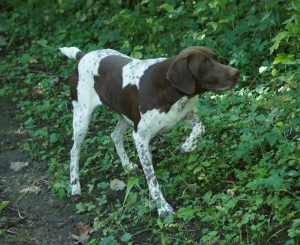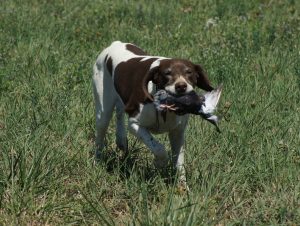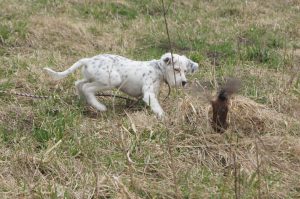Pointing Dog Pointers: Less is Better Than More
Pointing Dog Pointers
by Bob and Jody Iler
When we’re trying to be “successful” in life, doing more of the things that contribute to that success seems to make sense. When it comes to training our pointing dogs, many of us can fall into that same trap. If a thing is good, more should be even better, right?
For example, if our developing pup has one good retrieve, wouldn’t several more in the same training session be even better? If our pup is excited working with one or two birds in the field, why not work him on half a dozen to make him even more enthused? And wouldn’t it be better to incorporate several areas of bird dog training at the same time?
Let’s look first at birds. Beginning with the old wing and fish pole to test our pup’s pointing ability, could it hurt if we do this repeatedly? If pup starts to “catch” the wing, soon he will start to creep instead of remaining on point when he sees it. The same applies to the exercise of hiding a dead or hobbled bird in nearby cover for the pup to find. Once he learns that the bird isn’t going to fly away and he can catch it, he will no longer hold point when he first gets the bird scent.
As we go on to bird introduction, here is where “less is better” can be very important. Introducing the pup to one or two small, hobbled quail at first will ensure that pup won’t be frightened, but rather, intrigued and excited over this new and wonderful experience. This is particularly important with soft or shy puppies, where proper bird introduction lays the foundation for future success. Try to imagine what might happen if, instead, this shy pup was put into a pen full of flapping, flying birds, or—if the young pup’s first introduction to birds was a cackling rooster that flushed right in front of him, causing him to jump back in alarm.
Even if the pup is bold, it makes good sense to proceed slowly, with one or two birds in a session. This whets pup’s appetite for more and gives him something to think over in preparation for the next session. If you use too many birds in one training scenario, you may open yourself up to a whole bunch of things that can go wrong!
Fast forward to hunting season. The pup is now a young started dog, with a few hunting sessions with you below her belt. Since she’s doing so well, it’s probably a great idea to get this dog into a multitude of pheasants in theDakotas, right? Wrong! Taking a young and fairly inexperienced dog to areas where there are lots of birds is bound to overwhelm her. She may quit handling for you and not know which bird to work or point first. She might even quit hunting entirely. The young dog needs a gradual accumulation of good experiences to build on as she develops. Here again, less is more, especially at first.
In last month’s column, we focused on gun development. Let’s take it a step further now and assume you have a young dog developed to the gun. It should be OK to take a few friends along so you can show off your dog, shouldn’t it? And it shouldn’t matter if they shoot several times at a bird, right? After all, your dog is developed to the gun, isn’t he? Wrong!
Taking a young dog out with several hunters is not the best scenario. The dog may wonder who he should handle for and respond to. And only one person should be doing the shooting at any given time, and then, only one or two shots should be taken, and only for a bird that the dog has been working. Random shooting around a young dog can cause gun problems! When it comes to shooting and the youngster, less is better than more.
And while we’re talking about hunting scenarios, more dogs in the mix are a recipe for disaster when developing your young pointing dog. Here again, the need for your dog to bond and work with you while hunting will be stretched to the limit. Your dog will be distracted by the other dogs, and if they have bad habits, he may learn them as well. Hunting groups of dogs together with groups of hunters has never been our preference. There is a place for this if both hunters and dogs are well-trained; normally, it will always be much better for you, particularly with your young dog, if you remember that less is more: less gunfire, less (or no) fellow hunters, less (or no) other dogs in the field.
Let’s talk now about retrieving. Your “prodigy” pup has begun retrieving well for you. Each training session, she has one or two excellent retrieves. It might be a good idea to have three or four retrieves, instead of just one or two, in your training sessions, right? No! Ending a session with a good retrieve will teach your pup more than stretching a training session out and pushing the dog for one more . . . and one more. Often, that last one may not work out the way you expected, and to end your training on a bad note is not what you want for your pup.
Like everyone, we’ve been tempted to show off our dog to someone and push the envelope. We’ve learned over the years that the best training method for the retrieve is to keep it short and simple with one or two birds a session, and to stop right there after a successful retrieve. We once trained a young shorthair that was later sold to a man down South, who ran the shorthair with his pointers on lots of birds. He’d purchased the shorthair (a good retriever) specifically to do that job. Needless to say, as the shorthair ran with the pointers, he soon tired of retrieving and joined the others in their happy hunting!
Should you teach your young dog multiple exercises all at once? Though many bird dog training areas overlap, remember that training exercises are a pyramid, with each area logically built upon the other. For example, you don’t teach your pup to be steady to the flight of a bird before you’ve even developed the pup on birds and fostered his enthusiasm and love for hunting. You don’t begin gun development with a pup that hasn’t been introduced to birds and is working them with fire and zest.To qualify this, we have had clients who have told us of their “wonder” dogs—sharing stories and pictures of past dogs that have made hundreds of retrieves as game preserve dogs, etc. (One of these dogs, by the way, was aChesapeake.) This doesn’t mean that your pointing dog can’t do the same, maybe, in the future. But for the young dog, less retrieves are always better than too many.
Some exercises should never be taught simultaneously, such as the trained retrieve and steadying to wing and shot. In one instance, you are teaching the dog to stand his birds and remain motionless to the flight and shot; in the other, you are teaching the dog to retrieve them. These exercises should be taught separately and never to a developing young dog. Too much pressure, too soon, only serves a trainer’s agenda, never the dog’s best interest. Here again, less is better.
It should go without saying that overuse of the whistle and voice when training your dog will only result in teaching him to ignore you. “Never give a command you can’t enforce” is a good rule to keep uppermost in mind. And don’t put your pup in a position to disobey you by rushing your training along (without first laying a good foundation) and expect to control him with hollering and excessive whistling.
With patience, love and time you’ll find that training your dog with the “less is better than more” philosophy will reap years of reward!
Pointing Dog Pointers features monthly training tips by Bob and Jody Iler, who own Green Valley Kennels in Dubuque, Iowa. Bob and Jody have trained pointing dogs for over 35 years and have written many articles for The Pointing Dog Journal.








